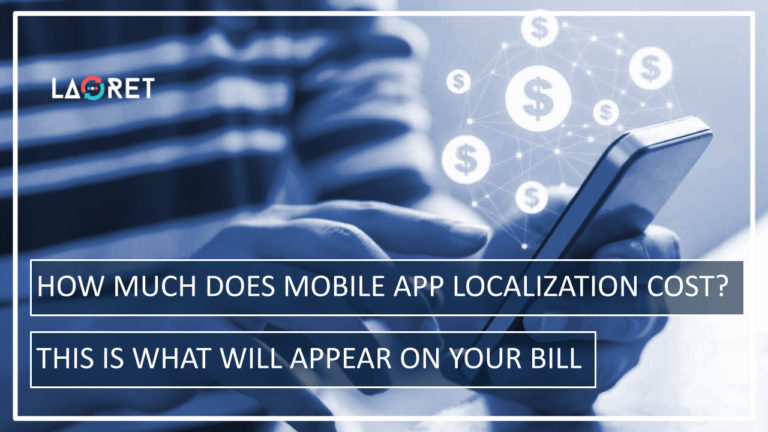How Much Does Mobile App Localization Cost? This Is What Will Appear On Your Bill
Mobile App localization has become a crucial business incentive for those looking to conquer global markets. In 2019 alone, more than 2 million apps were in the Google Play Store, and mobile phone users had reached 4,68 billion.1
Of course, deciding you want localization is the easy part. But how is Mobile App Localization charged? What are the services involved? And, what are the best ways to keep costs down? Find out!
The Cost Of Mobile App Localization: An Overview
First of all, let’s dig into the two strategies for Mobile App Localization. Although the choice between these is commonly based on the overall app expansion strategy, budget is a defining factor too. These are:
- Deep localization. Here, a select number of markets will be chosen, and everything in your app will be localized. This strategy only focuses on a few markets, but it allows you to dive more deeply into the localization process and get every detail right.
- Minimum Viable Localization (MVL). This strategy will suit you best if you want to reach a larger audience really quickly. With MVL, the mobile app isn’t localized from top to bottom, but minimal content and features are. Considered to be a healthy minimum, this strategy and level of localization aims to ensure that international users can understand and interact with the app. As the app gains popularity, more features and content will be localized.
Going for either one of these two strategies is a key factor in determining mobile app localization cost. But there’s more. Generally speaking, When it comes to a specific pricing model for mobile app localization, it is usually presented per word for the translation. Of course, translation is only a part of the Mobile App Localization and might be subject to that pricing model. However, there are other technical aspects involved that can’t follow the per-word pricing model. These technical services included in the mobile app localization process, such as DTP services, are commonly calculated based on hourly rates. To get a more realistic idea of the cost, we’ll explore key services involved in the process.
Internationalization
Mobile App Internationalization is the process of preparing and verifying that your app can support multiple languages. In truth, internationalization should be part of the development process since once the code is set up, it will be harder to modify.
Translating The Content
When it comes to translating the content, a qualified Language Service Provider (LSP) will push the content through the Translation, Editing, and Proofreading (TEP) process. This way, linguistic as well as cultural standards are respected, and quality is ensured. The translation process is charged per word.
Mobile App content cones in 3 main categories:
- In-App Content is the content the user encounters when using the app. In this step. The Resource File, the file that combines almost all of your strings, is translated into each target language.
- Non-String Content includes the non-textual features such as video, audio, numbers, currency, and so on.
- App Store Content is the content you find in the app store, and is, as a result, often the first content your user will be exposed to. That is why culturally adapted, savvy translations can make or break a sale, and are of vital importance even here. Store content includes text, videos, screenshots, app previews, sign-up flows, and so on.
Pro Tip! Learn all about the ins and outs of Mobile App Localization in our blog How To Use Mobile App Localization As A Smart Market Expansion Strategy.
While the per-word rate might seem straight-forward, there are some contributing factors to how high this rate may turn out to be. And for a large part, this will depend on which language pair you are requesting. For some language pairs, it will be harder to find qualified translators who also have industry-knowledge. Finding an expert for English French will be a lot easier than finding one for Danish Korean. Since the pool of linguists to choose from will be a bit more shallow, the per word rate will inevitably go up.
Images And Multimedia. What About Them?
Mobile Apps can differ greatly in terms of complexity. This means that depending on your concept and goals, additional services such as multimedia localization may be needed.
- Multimedia services may be involved in mobile app localization in a minimal way. These can include voice-over or even subtitling services. When it comes to Voice-Over Localization, Production Hours, Output Hours, use of resources, are all part of the eventual bill. Commonly, Voice-Over includes transcription. And while translation is charged per word, transcription is charged per minute, and the recording can be charged per day (or even half day) or per hourly sessions.
- Images or any personalized characters that are featured in your app may also need to be adapted to fit local preferences. The localization of images and characters might be charged by the hour.
Pro tip! Learn more about how the costs for voice-over and subtitling services are calculated in our blogs on multilingual voice-over: get in on the action, and, deciphering the cost of your subtitling services.
Mobile App Optimization
So, how do you know your mobile app will perform and actually appear in the app store? This is where mobile app optimization comes in. When it comes to mobile app localization, the so-called ASO Strategy is commonly followed. This strategy involves:
- International SEO and keyword localization that will generate conversions. This will include optimizing the title, description, and keywords, each with a targeted translation.
- Strong marketing content geared towards each specific locale you intend to target. for this, make sure you look into localization and transcreation services.
- Optimization and localization of visual features such as previews and videos
- App graphics carefully selected to speak to the target locale and demographic
- Social media strategies to generate traffic for your play store entry. This will involve organic as well as paid strategies.
Mobile App Localization Strategies: Mobile Testing & QA
Mobile Apps can be a minefield of bugs, so it is essential that it is tested properly prior to release. The ideal procedure will involve both Smoke and Beta Tests to confirm that the app functions maintain their performance with the target language(s) added.

Strategies That Can Affect The Cost Of Mobile App Localization
Of course, when talking about the cost of your Mobile App Localization Services, it is not just about which service will be charged and how. Many clients are unaware that they are able to influence the eventual price tag by providing the LSP with the information they need to make the process run more smoothly. Similarly, the LSP will integrate certain tools and adhere to workflows to boost efficiency and keep down the costs, especially in the long run.
As a general rule, we’d like to stress that mobile app localization is a long and complex process. So, prior to committing to localization, make sure you have your budget and business priorities in order. For example, you won’t have to translate into all languages straight after the internationalization process. Take your time to assess where it would be best for you to start, and take the following tips into account once you do!
From The Client Perspective
Getting the best localized version of your product in an efficient and economical manner is possible. So, here are some best practices that you may want to consider as you start.
- Decide if the app will be translated into one language or multiple languages and if these languages have complex script and writing systems. The more languages (and the more complex the languages) you require, the greater the effort, and the bigger the teams and budget. One thing we can recommend here is that you start with one language at a time so that you can avoid any hassle and most importantly cost overruns.
- Provide Context to the translators to prevent the otherwise inevitable back and forth of corrections and questions. Include screenshots of anything that makes yourapp unique or any special features you would like to focus on.
- Add comments to the strings with context for each section.
- If possible, share the app itself and allow the translators to familiarize themselves with it from the user perspective. Allow them to download it from the App Store, so that they will also have the context they need for translating the in-store content.
- Remember that as your app needs updating, localization will as well. This will require continuous localization where any new features and updates are regularly localized for your multilingual audiences. Make sure you connect with one LSP for the whole process, so cost-effective, long-term solutions can be offered.
- Apps release dates can be quite aggressive, it’s understandable. But this can dramatically increase the cost of your mobile app localization projects. A golden rule of thumb is to plan ahead. Localization shouldn’t be an afterthought. Localization should be considered during the first phases of app development, which will reduce not only the amount of time to localize but also the amount of effort and cost.
From The LSP Perspective
A quality LSP offers the services of continuous localization to make this part of the process run smoothly.
For this, they will use a Translation Management System (TMS) and Translation (CAT) tools. With a TMS & CAT tool, you can cut costs drastically and boost productivity by taking advantage of the localization process automation and ensure that:
- Any updates are extracted, translated, and inserted without bugs and issues.
- A Translation Memory (TM) is leveraged so that the previously translated terminology is saved, and you pay less for repeated words. The TM along with careful terminology management also ensures that consistency is maintained throughout.
- The TMS also enables teams to work together productively, boosting efficiency.
Conclusion
The cost of Mobile App localization is determined by your word count, language pair, and the complexity of your project. While many of these factors will be determined up front, there are aspects that will influence the eventual price tag. Make sure you provide your LSP with plenty of visual materials and context and select an LSP that uses innovative tools and optimized processes. At Laoret, we work with native, in-country linguists and localization engineers with years of experience in your industry. We combine top quality human expertise with internally developed TMS and tools, designed to be tailored to your needs.






